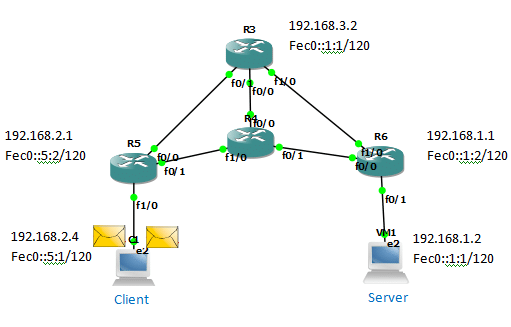IPv6, the successor to IPv4, introduced several routing protocols for efficient and scalable routing in IPv6 networks. Three commonly used IPv6 rou ting protocols are RIPng, OSPFv3, and BGP (Border Gateway Protocol). Let’s explore each of these protocols in more detail:
- RIPng (Routing Information Protocol next generation):
- RIPng is an extension of the original RIP protocol designed for IPv6 networks.
- It uses distance-vector routing, where routers exchange routing information with their directly connected neighbors.
- RIPng uses hop count as the metric to determine the best path to a destination.
- It is a simple and easy-to-configure protocol suitable for small to medium-sized networks.
- RIPng is not widely used in large-scale enterprise networks but can be helpful in simpler environments.
- OSPFv3 (Open Shortest Path First version 3):
- OSPFv3 is the IPv6 version of OSPF, a link-state routing protocol widely used in IPv4 networks.
- OSPFv3 provides efficient and scalable routing by constructing a network topology and calculating the shortest path to each destination.
- It supports multiple areas, allowing large networks to be divided into smaller manageable areas.
- OSPFv3 uses a hierarchical design with designated routers (DR) and backup designated routers (BDR) to minimize routing updates.
- It is a robust and feature-rich protocol suitable for medium to large enterprise networks.
- BGP (Border Gateway Protocol):
- BGP is an inter-domain routing protocol used for exchanging routing information between different autonomous systems (AS) on the Internet.
- BGP is used to establish and maintain routing policies between different organizations or ISPs.
- BGPv4, the current version, supports IPv6 routing through the use of address families.
- It utilizes path-vector routing, considering multiple attributes to determine the best path, such as AS path, network policies, and path attributes.
- BGP is a complex and highly configurable protocol mainly used by Internet service providers (ISPs) and large enterprises for external routing.
These protocols provide different features and capabilities for routing in IPv6 networks. The choice of protocol depends on the network size, complexity, and requirements. RIPng is suitable for small networks, OSPFv3 for medium to large networks, and BGP for inter-domain routing and large-scale networks.
SHARE
